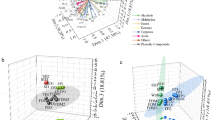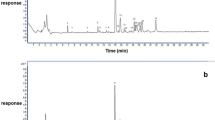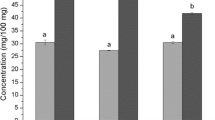Abstract
The effect of drying temperatures on the profile of volatile compounds of pasta was studied. The solid phase microextraction coupled with gas chromatography/mass spectrometry allowed to identify 72 volatile compounds in the samples of not-dried, low-temperature-dried (LT-dried), high-temperature-dried (HT-dried), and wrongly very-high-temperature-dried (WVHT-dried) pastas. The samples of not-dried pasta contained alcohols, aldehydes, short-chain ketones, esters, furans, and some sulfur compounds. In the LT-dried pasta, the volatile aldehydes derived from lipid oxidation were more abundant than in HT-dried pasta. HT-dried pasta showed higher levels of furan and furan derivatives (especially 2-furanmethanol), derived from the Maillard reaction, than LT-dried pasta (p < 0.05). Pyrazines arose from WVHT treatment. Significant differences were observed also for the color indices when comparing pasta subjected to LT and HT drying (p < 0.001). Several volatile Maillard reaction products were significantly correlated (p < 0.05 and p < 0.01) to a* and 100 − L*. The ratio aldehydes/furans allowed distinguishing in a significant way the treatments, independently from the lot characteristics.




Similar content being viewed by others
References
AACC. (2000). Approved methods of the American Association of Cereal Chemists (10th ed.). St. Paul: American Association of Cereal Chemists.
Aktan, B., & Khan, K. (1992). Effect of high-temperature drying of pasta on quality parameters and on solubility, gel electrophoresis, and reverse-phase high-performance liquid chromatography of protein components. Cereal Chemistry, 69, 288–295.
Ampuero, S., & Bosset, J. O. (2003). The electronic nose applied to dairy products: A review. Sensors and Actuators B: Chemical, 94, 1–12.
Anese, M., Nicoli, M. C., Massini, R., & Lerici, C. R. (1999). Effects of drying processing on the Maillard reaction in pasta. Food Research International, 32, 193–199.
Baiano, A., Siciliano, P., & Taurino, A. (2007). Electronic nose and GC-MS to investigate the volatile component of an Italian traditional pasta. Cereal Foods World, 52, 138–143.
Beleggia, R., Platani, C., Spano, G., Monteleone, M., & Cattivelli, L. (2009). Metabolic profiling and analysis of volatile composition of durum wheat semolina and pasta. Journal of Cereal Science, 49, 301–309.
Berghofer, L. K., Hocking, A. D., Miskelly, D., & Jansson, E. (2003). Microbiology of wheat and flour milling in Australia. International Journal of Food Microbiology, 85, 137–149.
Bills, D. D., & Keenan, T. W. (1968). Dimethyl sulfide and its precursor in sweet corn. Journal of Agricultural and Food Chemistry, 16, 643–645.
Coghe, S., Gheeraert, B., Michiels, A., & Delvaux, F. R. (2006). Development of Maillard reaction related characteristics during malt roasting. Journal of the Institute of Brewing, 112, 148–156.
D’Egidio, M. G., Mariani, B. M., Nardi, S., Novaro, P., & Cubadda, R. (1990). Chemical and technological variables and their relationships: A predictive equation for pasta cooking quality. Cereal Chemistry, 67, 275–281.
Decree of the President of the Italian Republic no. 187 of 9 February, 2001. Regolamento per la revisione della normativa sulla produzione e commercializzazione di sfarinati e paste alimentari, a norma dell’articolo 50 della legge 22 febbraio 1994, n. 146. Official Italian Journal, 117, 6-13
Dexter, J. E., Matsuo, R. R., & Morgan, B. C. (1981). High temperature drying: Effect on spaghetti properties. Journal of Food Science, 46, 1741–1746.
Feillet, P., Autran, J., & Icard-Vernière, C. (2000). Pasta brownness: an assessment. Journal of Cereal Science, 32, 215–233.
Forss, D. A. (1972). Odor and flavor compounds from lipids. In R. T. Holman (Ed.), Progress in chemistry of fats and oils, vol 13, Part 4. New York: Pergamon.
Güler, S., Köksel, H., & Ng, P. K. W. (2002). Effects of industrial pasta drying temperatures on starch properties and pasta quality. Food Research International, 35, 421–427.
Hansen, A., & Schieberle, P. (2005). Generation of aroma compounds during sourdough fermentation: Applied and fundamental aspects. Trends in Food Science and Technology, 16, 85–94.
Honold, G., & Farkas, G. (1966). The oxidation-reduction enzymes of wheat. Cereal Chemistry, 43, 517–5229.
Hoskins, C. M., & Hoskins, G. G. (1959). A window on methods and problems in today’s macaroni industry. Cereal Science Today, 4, 31–33.
Jousse, F., Jongen, T., Agterof, W., Russell, S., & Braat, P. (2002). Simplified kinetic scheme of flavor formation by the Maillard reaction. Journal of Food Science, 67, 2534–2542.
Kazeniac, S. J., & Hall, R. M. (1970). Flavor chemistry of tomato volatiles. Journal of Food Science, 35, 519–530.
Kumar, A., Gaurav, Malik, A. K., Tewary, D. K., & Singh, B. (2008). A review on development of solid phase microextraction fibers by sol–gel methods and their applications. Analytica Chimica Acta, 610, 1–14.
Mac Dougall, D. B., & Granov, M. (1998). Relationship between ultraviolet and visible spectra in Maillard reactions and CIELAB colour space and visual appearance. In J. O’Brien, H. E. Nursten, M. J. C. Crabbe, & J. M. Ames (Eds.), The Maillard reaction in foods and medicine. Cambridge: The Royal Society of Chemistry.
Maga, J. A. (1978). Cereal volatiles, a review. Journal of Agricultural and Food Chemistry, 26, 175–178.
Morales, F. J., & van Boekel, M. A. J. S. (1998). A study on advanced Maillard reaction in heated casein/sugar solutions: colour formation. International Dairy Journal, 8, 907–915.
Osada, Y., & Shibamoto, T. (2006). Antioxidative activity of volatile extracts from Maillard model systems. Food Chemistry, 98, 522–528.
Paradiso, V. M., Summo, C., Trani, A., & Caponio, F. (2008). An effort to improve the shelf life of breakfast cereals using natural mixed tocopherols. Journal of Cereal Science, 47, 322–330.
Paradiso, V. M., Summo, C., Pasqualone, A., & Caponio, F. (2009). Evaluation of different natural antioxidants as affecting volatile lipid oxidation products related to off-flavours in corn flakes. Food Chemistry, 113, 543–549.
Pavan, G. (1980). High temperature drying improves pasta quality. Food Engineering International, 5, 37–39.
Peris, M., & Escuder-Gilabert, L. (2009). A 21st century technique for food control: electronic noses. Analytica Chimica Acta, 638, 1–15.
Rehman, S., Paterson, A., & Piggott, J. R. (2006). Flavour in sourdough breads: a review. Trends in Food Science and Technology, 17, 557–566.
Reid, L. M., O’Donnell, C. P., & Downey, G. (2006). Recent technological advances for the determination of food authenticity. Trends in Food Science and Technology, 17, 344–353.
Ren, Y. L. (2001). Comparison of solvent extraction and microwave extraction for release of dimethyl sulfide from cereals and canola. Journal of Agricultural and Food Chemistry, 49, 1737–1739.
Ren, Y. L., Desmarchelier, J. M., Williams, P., & Delves, R. (2001). Natural levels of dimethyl sulfide in rough rice and its products. Journal of Agricultural and Food Chemistry, 49, 705–709.
Resmini, P., & Pellegrino, L. (1994). Occurrence of protein-bound lysylpyrrolaldehyde in dried pasta. Cereal Chemistry, 71, 254–262.
Resmini, P., Pellegrino, L., & Battelli, G. (1990). Accurate quantification of furosine in milk and dairy products by a direct HPLC method. Italian Journal of Food Science, 2, 173–183.
Resmini, P., Pellegrino, L., Pagani, M. A., & De Noni, I. (1993). Formation of 2-acetyl-3-D-glucopyranosylfuran (glucosylisomaltol) from nonenzymaytic browning in pasta drying. Italian Journal of Food Science, 5, 341–353.
Rivas-Canedo, A., Fernandez-Garcia, E., & Nunez, M. (2009). Volatile compounds in fresh meats subjected to high pressure processing: Effect of the packaging material. Meat Science, 81, 321–328.
Sucan, M., & Weerasinghe, D. (2005). Process and reaction flavors: An overview. In M. Sucan & D. Weerasinghe (Eds.), Process and reaction flavors. Recent developments. Washington: American Chemical Society.
Summo, C., Caponio, F., Paradiso, V.M., Tricarico, F., Bilancia, M.T., & Pasqualone, A. (2009). Evolution of the volatile compounds in vacuum-packed ripened sausages during storage. Italian Journal of Food Science, Special issue, 37–40.
van Boekel, M. A. J. S. (2006). Formation of flavour compounds in the Maillard reaction. Biotechnology Advances, 24, 230–233.
van der Meulen, R., Scheirlinck, I., Van Schoor, A., Huys, G., Vancanneyt, M., Vandamme, P., et al. (2007). Population dynamics and metabolite target analysis of lactic acid bacteria during laboratory fermentations of wheat and spelt sourdoughs. Applied and Environmental Microbiology, 73, 4741–4750.
Villberg, K., Veijanen, A., Gustafsson, I., & Wickström, K. (1997). Analysis of odour and taste problems in high-density polyethylene. Journal of Chromatography. A, 791, 213–219.
Wu, D., & Sun, D.-W. (2013). Colour measurements by computer vision for food quality control—A review. Trends in Food Science & Technology, 29, 5–20.
Zhang, L., Nishizu, T., Hayakawa, S., Nakashima, R., & Goto, K. (2012). Effects of different drying conditions on water absorption and gelatinization properties of pasta. Food and Bioprocess Technology. doi:10.1007/s11947-012-0976-5. Published online: 14 October 2012.
Author information
Authors and Affiliations
Corresponding author
Rights and permissions
About this article
Cite this article
Pasqualone, A., Paradiso, V.M., Summo, C. et al. Influence of Drying Conditions on Volatile Compounds of Pasta. Food Bioprocess Technol 7, 719–731 (2014). https://doi.org/10.1007/s11947-013-1080-1
Received:
Accepted:
Published:
Issue Date:
DOI: https://doi.org/10.1007/s11947-013-1080-1




